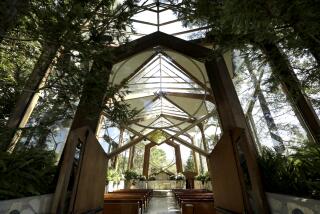No Swallows, Yet : New Church Nearly Ready at San Juan
- Share via
The new seven-domed parish church of Mission San Juan Capistrano, impressively visible for miles above trees and lesser buildings, probably will be completed late in September, more than a year behind schedule--but there is good reason for the delay.
“It’s because this structure is one of a kind,” said Richard F. Landy, church spokesman and director of tourism for the city. “Almost everything had to be ordered specially from faraway places. There were things we just couldn’t get from the usual construction sources.”
Things such as cast stonework from Utah, 10 crystal chandeliers from Belgium and eight bronze bells from Holland.
The structure is “an architectural reproduction” of the Old Mission Church, which was crumbled by an earthquake more than 170 years ago. Forty worshipers died in the rubble on Dec. 8, 1812, and since then the ruins and the adjacent gardens and other old buildings have served as a sort of shrine for tourists and the faithful, and have become known worldwide as a nesting place for the swallows that return each spring.
Pigeons already make use of the new bell tower, which rises 103 feet with a nine-foot lantern and cross on top. The swallows haven’t found it yet.
The cluster of bells is called a “peal.” The largest of them weighs 4,730 pounds. Their reverberating songs might discourage the swallows from building
nests in the lofty, windy aerie, Landy said.
The bells were donated to the Mission by Arthur B. and Gaye L. Birtcher and were dedicated last March by the Most Rev. William R. Johnson, bishop of Orange, whose name is inscribed on the largest bell.
Landy said the domes will probably be painted a rust red to contrast with the church’s white walls and towers.
The new church will be, essentially, a duplicate of the old one, except it will be 15% larger, Landy said. From above, it will appear in the shape of a Latin cross, with the main dome rising 90 feet above the point where the arms meet. It is capped by an 18-foot lantern and cross.
Earthquake in Mind
The tragedy that is written in the wreckage of the Old Church a few yards away obviously dominated the schemes of the builders of the new $5-million sanctuary.
While the old one was built of unreinforced rock and mortar, architect John Bartlett of Arcadia and builder Joseph Byron of Whittier are working with a structural steel frame on a concrete foundation supported on driven steel piles. The “skin” is of a lightweight plastic material.
“It meets every (earthquake) standard in the book,” Bartlett said last year when the framework had been completed. “The steel framework is strengthened by reinforced arches. It should stand up to almost anything.”
Inside, carved wooden pews for 800 worshipers are in place, along with the 10 Belgian crystal chandeliers. The walls, purposefully made just a little irregular to resemble the walls of the Old Church, are covered with Spanish-Indian-Mission-style paintings of vases of flowers and representations of the 12 apostles. The artist was Norman Neuerburg, of Los Angeles, an art historian.
Some of the designs, especially in and around the altar and the sanctuary, are copies of those that still can be seen in the remains of the corresponding sections of the Old Church. Some of the interior decorative cast stonework--made of a material which looks like stone --also is imprinted with copies of designs from the original.
Increased Seating Space
The seating capacity of 800 will tend to “ease the workload” of Father Paul Martin and his staff of the Old Church, Landy said.
For many years, the priest has been conducting 10 Masses each week in the small but exquisite Serra Chapel which, although directly behind the church that was ravaged by the quake, escaped damage. The chapel holds only 200 worshipers.
“He’ll still have a Mass there every morning at 7,” Landy said. “But the seating capacity of the new church will allow him to hold three fewer Masses on Saturdays and Sundays while still serving the same number of parishioners.”
During the construction work, which began in June, 1982, all the earth that was scooped up was taken in catalogued units to a nearby nursery where it was examined for Indian artifacts by archeologist Nicholas M. Magalousis. The same procedure is being followed in work at the parking lot, dotted by old pepper trees, behind the church at the corner of Camino Capistrano and Acjachema Street.
Magalousis, who is director of the Mission museum, said nothing of real significance has turned up so far, only some tiles, small animal bones and some rather recent shards of pottery.
More to Read
Sign up for Essential California
The most important California stories and recommendations in your inbox every morning.
You may occasionally receive promotional content from the Los Angeles Times.










